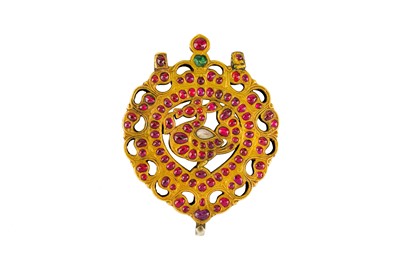28th Apr, 2023 14:00
Islamic & Indian Art
A FINE GEM-SET HAMSA DUCK PENDANT (PADHAKKAM)
Tamil Nadu, Southern India, 19th century
A FINE GEM-SET HAMSA DUCK PENDANT (PADHAKKAM)
Tamil Nadu, Southern India, 19th century
Of inverted drop-like shape, with two square lugs at the top and another diamond-shaped at the bottom, the central medallion presenting a Hamsa duck (white goose) with a voluminous upward-turned tail, the gold front finely encrusted with untested, mostly cabochon-cut gems, including rubies, a small emerald bead, and an almond-shaped table-cut diamond, the parcel gilt reverse incised to highlight the details of the bird's plumage and the leaves' edges in the scrolling vegetal meanders framing the pendant, 4.5cm x 3.5cm at widest points, 10.08gr.
Hamsa ducks (Anser indicus) are a species of Indian aquatic migratory birds of great prominence and relevance in Hindu iconography, often represented as white swans or geese. In Hinduism, it is believed this bird is the vahana (vehicle) of Brahma, the god of Creation, and as such, it is associated with the Sun, as well as male fertility, knowledge, and purity. The name Hamsa is derived from the exhalation of the Sanskrit sound 'ham' and the inhalation of 'sa', constituting the return of the life force to Brahman, its cosmic source (O. Untracht, Traditional Jewelry of India, 2008, p. 266, fig. 625).
South Indian jewellery distinguishes itself from its Northern Indian counterpart through a ubiquitous presence of subjects drenched in Hindu culture and religion, including hamsa ducks and often Hindu deities. Fostered by the local abundance of mineral wealth, especially of diamonds, rubies, pearls, and gold, South Indian jewels never shy away from the opulent combination of these materials. Interestingly, jewellery in the south of the Subcontinent, unlike the northern one, did not evolve in response to changing fashions and old designs, rooted in the historical past of the region dating back to the Medieval Chola dynasty, were still prominent and en vogue until recent years (Usha R. Balakrishnan, Dance of the Peacock: Jewellery Traditions of India, 2010, p. 104). For analogous pendants with aviary motifs, please see in the same publication figs. 121a-b, 134, and 140.
Do you have an item similar to the item above? If so please click the link below to submit a free online valuation request through our website.





